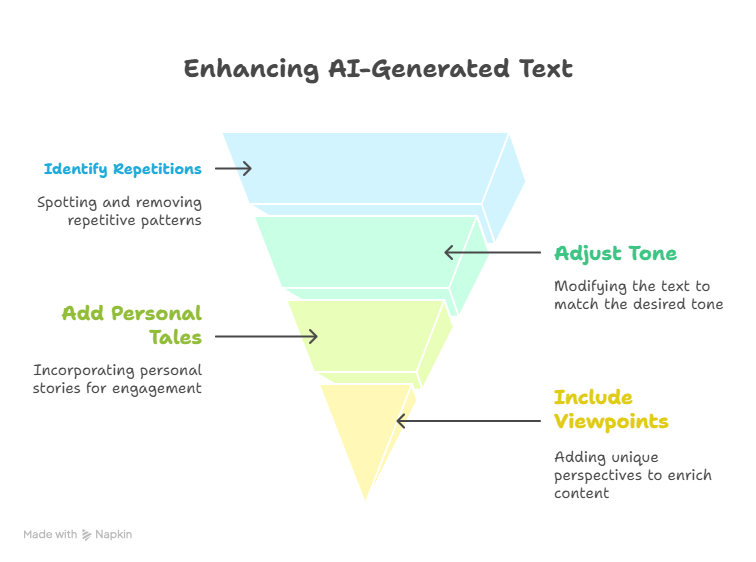According to recent industry reports, an astounding 80% of businesses are anticipated to implement AI-powered content generation tools by 2025. The demand for effective, superior content production is what is causing this change. However, readers are more likely to notice AI-generated content as it becomes more common.
The difficulty is in producing content that appeals to human readers without being identified as artificial intelligence (AI) generated. With its sophisticated natural language processing features, ChatGPT provides an answer. Businesses can create captivating, realistic-sounding content that enthralls their audience by utilizing artificial intelligence.
The advantages of using ChatGPT for content creation are examined in this introduction, which also offers advice on how to produce AI content that is invisible.
Understanding ChatGPT’s Capabilities and Limitations
The way we engage with AI chatbots has been completely transformed by ChatGPT, but producing quality content requires an awareness of both its advantages and disadvantages. ChatGPT is an advanced conversational AI that uses input to produce text that is human-like.
How ChatGPT Generates Text
ChatGPT generates and predicts text using a sophisticated language model. In order to learn patterns and relationships within language and generate responses that are both coherent and contextually relevant, this process entails analyzing enormous amounts of data.
Common Patterns That Signal AI-Generated Content
Even with its improvements, content produced by AI frequently displays specific patterns that can identify its artificial origin. These include using language that is too formal or repetitious, not understanding subtleties, and occasionally using language that is a little off-key.
The Ethics of Using AI for Content Creation
There are ethical questions when using AI chatbots, such as ChatGPT, to create content. AI has the potential to greatly increase efficiency and productivity, but in order to maintain authenticity and transparency, AI-generated content must be balanced with human review.
| Capability | Limitation |
|---|---|
| Generates human-like text | May lack nuanced understanding |
| Enhances productivity | Can produce repetitive content |
| Improves efficiency | Requires human oversight |
ChatGPT for Natural Content: Techniques and Best Practices
Understanding the methods and best practices that make AI-generated text more human-like is crucial if you want to use ChatGPT to create content that sounds natural. When used properly, ChatGPT can generate high-quality content by utilizing chatbot technology and machine learning developments.
Crafting Effective Prompts for Human-Like Responses
Creating compelling prompts is essential to getting responses from ChatGPT that resemble those of a human. This entails being precise, giving background information, and specifying the desired output’s tone and style. For example, give specific details and limitations to direct the AI rather than posing a general query.
You can design complex prompts with gpt-3 that elicit thorough and pertinent answers. Knowing how to phrase your prompts will help you maximize the AI’s potential.
Editing and Personalizing AI-Generated Text
To make the text sound more natural, it is essential to edit and customize it after ChatGPT has generated the content. This entails checking the output for repetitive or robotic patterns and adjusting it to better fit the desired tone and aesthetic.

The content can be greatly improved by including personal tales or distinctive viewpoints, which will make it more approachable and interesting for readers.
Avoiding Detection: Key Strategies
It takes a combination of tactics to avoid being identified as AI-generated content. Adding personal tales and distinctive viewpoints, as well as changing up the vocabulary and sentence structure, are two important strategies.
Varying Sentence Structure and Vocabulary
A more dynamic and organic flow can be achieved by varying the vocabulary and sentence structure. Using synonyms to prevent repetition and alternating between short and long sentences are two ways to accomplish this.
Adding Personal Anecdotes and Unique Perspectives
The content gains a human touch when personal tales and distinctive viewpoints are incorporated. By doing this, the text becomes more interesting and is less likely to be identified as artificial intelligence.
You can use ChatGPT to create content that sounds natural and connects with your audience by putting these strategies and best practices into practice.
Maximizing the Potential of ChatGPT for Natural Content
Content producers can use ChatGPT to create natural, high-quality content that connects with their audience by being aware of its advantages and disadvantages. Creating thoughtful prompts, revising, and customizing the generated text to ensure it satisfies the required standards are all necessary for efficient use of ChatGPT.
This article’s methods and best practices show how to use ChatGPT to produce interesting content that doesn’t look artificial intelligence (AI) generated. ChatGPT has the potential to completely transform content creation as AI develops further, empowering both individuals and companies to easily create engaging, organic content.
The art of producing natural content is made easier with ChatGPT, freeing up creators to concentrate on what really counts: connecting with their audience through their message. Content producers can open up new avenues for communication and storytelling by utilizing ChatGPT and its features.
FAQ
What is ChatGPT and how does it work?
ChatGPT is a type of conversational AI that uses natural language processing (NLP) and machine learning to generate human-like text. It is based on the GPT-3 language model, which is trained on a vast amount of text data to understand and respond to a wide range of questions and prompts.
Can ChatGPT replace human writers and content creators?
While ChatGPT can generate high-quality content, it is not intended to replace human writers and content creators. Instead, it is designed to assist and augment their work, helping to automate routine tasks and provide suggestions for improvement.
How can I ensure that the content generated by ChatGPT is not detectable as AI-generated?
To avoid detection, it’s essential to craft effective prompts, edit and personalize the AI-generated text, and vary sentence structure and vocabulary. Adding personal anecdotes and unique perspectives can also help to make the content more natural-sounding.
Is it ethical to use AI for content creation?
The ethics of using AI for content creation depend on the context and purpose of the content. While AI can be a valuable tool for content creation, it’s crucial to be transparent about the use of AI-generated content and to ensure that it is not used to deceive or mislead readers.
Can ChatGPT be used for other applications beyond content creation?
Yes, ChatGPT can be used for a range of applications, including customer service, language translation, and text summarization. Its conversational AI capabilities make it a versatile tool that can be adapted to various use cases.
How does ChatGPT’s language model compare to other AI chatbots?
ChatGPT’s language model is based on the GPT-3 architecture, which is one of the most advanced language models available. While other AI chatbots may use similar technology, ChatGPT’s capabilities and performance are highly regarded in the field of NLP and conversational AI.




